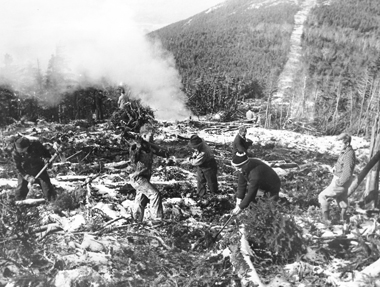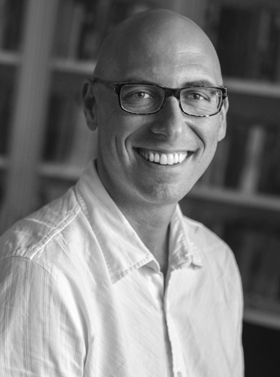Happy Trails, Ecologically
 |
|
Construction of the Taft Trail on Cannon Mountain in New Hampshire circa 1933. (Photo courtesy of the New England Ski Museum) |
ALBANY, N.Y. (April 5, 2017) — Most environmental histories of skiing have emphasized the industry’s ecological depredations, which makes sense: Modern ski resorts and the infrastructure required to operate them are incredibly resource intensive.
But when assistant professor Christopher Pastore of the History department was in grad school at the University of New Hampshire, he found a far different trail had once been successfully charted in that state, led by a unique “economic pragmatist, ecological tinkerer and consummate outdoorsman” named Henry Ives Baldwin (1896-1992).
The subject was a natural for Pastore, a social and cultural historian who examines the human dimensions of environmental change and who is, he explained, “an avid downhill and cross-country skier who just loves to poke around forests in the winter.”
He recently returned to the subject, authoring “Skiing Turns Through the Timber: Cutting a Trail Toward Multi-Use, Ecological Forestry” for a 2017 special issue on winter ecology in the journal Northeastern Naturalist. The publication assembled an interdisciplinary collection of new research conducted by several prominent environmental historians and ecologists.
Pastore was fascinated by the professional dexterity of Baldwin, a forester who sought efficiency of timber production but who was also a botanist attuned and sensitive to resultant ecological changes.
“A closer look at New Hampshire and a closer look at Baldwin and the skiers with whom he collaborated reveals a sensitivity to mountain ecology that anticipated ‘multi-use’ approaches to forest management well before they became federal policy in 1960,” said Pastore. “Their ecological approaches to mountain management thereby made important contributions to the emerging science of winter.”
 |
|
Christopher Pastore of History. |
Foresters in New Hampshire worked closely in many cases with expert skiers in designing down-mountain trails. As Pastore wrote: “No longer was forestry confined to hydrology reports and timber stock assessments. Recreation was now integral to forest management plans.” Unlike the Alps, where ski trails could be created above the tree lines, greater care had to be used in New Hampshire’s tree-covered peaks.
Baldwin led these concerns. Holder of a PhD in botany from Yale, he promoted installations of new seedlings and grasses to both prevent soil erosion and lengthen snow cover. He argued for native leaf mold or compost as fertilizers over the chemical variety. He and his cohort also helped establish a more scientific system of snow classification, using terms such as trap crust, marble crust, film crust, and others.
“In writing this, I gained a deeper understanding of environmental science in the early 20th century and a greater appreciation for the ways that seasonal variation shaped scientific understanding,” said Pastore. “As an environmental historian who interrogates the connections between human progress and the natural world, my findings in this paper will surely inform my future work.”
Pastore said another extremely valuable lesson he learned was that historians must check the tendency to solely associate historical change — environmental or otherwise — with impersonal processes. Change, he noted, is also contingent upon charismatic individuals. Such was Baldwin, whose lessons were not always followed as other states, and their resource-intensive commercial ski industries, overtook New Hampshire.
“Baldwin’s papers reveal a brief window of more sustainable modes of mountain management on public lands,” said Pastore. “But as skiing increased in popularity and then spread to states that privileged ski resort development of private lands, that window closed.”
Yet the environmental knowledge Baldwin fostered is there to be rediscovered. But, he attests, we must take narrative sources seriously as forms of environmental evidence.
“I would say the thing I admired most about Baldwin was the way his personal interests dovetailed with his intellectual pursuits,” said Pastore. “He simply loved messing around in the mountains. But he was also a trained scientist, so he had a penchant for methodical investigation.
“In short, he took what he loved and endeavored to learn as much as he could about it. And he did that throughout his life. So perhaps he and I are a lot alike.”
![]() For more news, subscribe to UAlbany's RSS headline feeds
For more news, subscribe to UAlbany's RSS headline feeds
A comprehensive public research university, the University at Albany-SUNY offers more than 120 undergraduate majors and minors and 125 master's, doctoral and graduate certificate programs. UAlbany is a leader among all New York State colleges and universities in such diverse fields as atmospheric and environmental sciences, business, education, public health,health sciences, criminal justice, emergency preparedness, engineering and applied sciences, informatics, public administration, social welfare and sociology, taught by an extensive roster of faculty experts. It also offers expanded academic and research opportunities for students through an affiliation with Albany Law School. With a curriculum enhanced by 600 study-abroad opportunities, UAlbany launches great careers.


